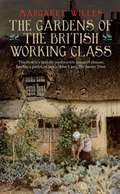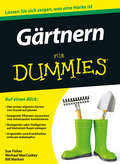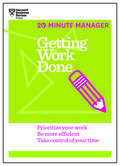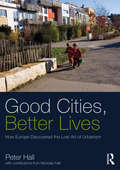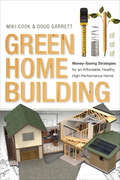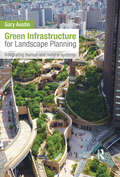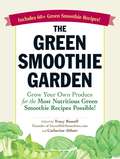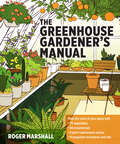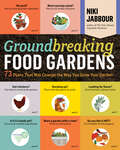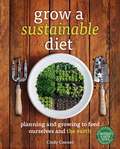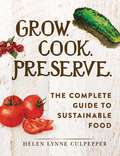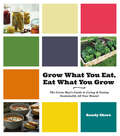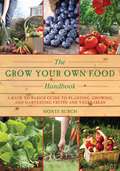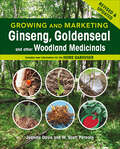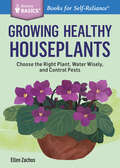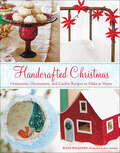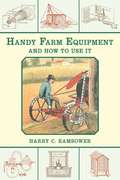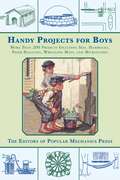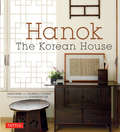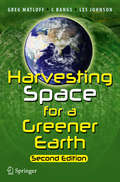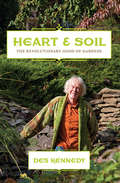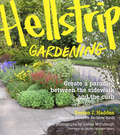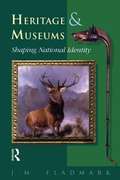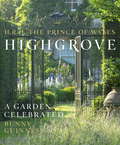- Table View
- List View
The Gardens of the British Working Class
by Margaret WillesThis magnificently illustrated people's history celebrates the extraordinary feats of cultivation by the working class in Britain, even if the land they toiled, planted, and loved was not their own. Spanning more than four centuries, from the earliest records of the laboring classes in the country to today, Margaret Willes's research unearths lush gardens nurtured outside rough workers' cottages and horticultural miracles performed in blackened yards, and reveals the ingenious, sometimes devious, methods employed by determined, obsessive, and eccentric workers to make their drab surroundings bloom. She also explores the stories of the great philanthropic industrialists who provided gardens for their workforces, the fashionable rich stealing the gardening ideas of the poor, alehouse syndicates and fierce rivalries between vegetable growers, flower-fanciers cultivating exotic blooms on their city windowsills, and the rich lore handed down from gardener to gardener through generations. This is a sumptuous record of the myriad ways in which the popular cultivation of plants, vegetables, and flowers has played-and continues to play-an integral role in everyday British life.
Gärtnern für Dummies (Für Dummies)
by Sue Fisher Michael MacCaskey Bill MarkenWenn Sie nicht nur Ihrem grünen Daumen vertrauen wollen Haben Sie ein Stück Erde, das Sie in einen Garten verwandeln möchten, aber außer der Freude an erdverschmierten Händen, sattem Grün und Farbenpracht noch recht wenig Ahnung von Gartenarbeit? Dann ist Gärtnern für Dummies das richtige Buch für Sie! Hier erhalten Sie konkrete Hilfestellung bei der Planung Ihres Gartens und der Wahl der für Sie und Ihr Stück Land passenden Pflanzen. Lernen Sie, wie Sie aus Bäumen, Büschen und Blumen ein harmonisches Ganzes schaffen und mit einjährigen und mehrjährigen Pflanzen Ihren Garten zum Blühen bringen. Außerdem enthält das Buch viele nützliche Tipps zum richtigen Gartengerät, zur Hege und Pflege der Pflanzen, zur Schädlingsbekämpfung und zum Kompostieren.
Getting Work Done
by Harvard Business ReviewOverwhelmed by the sheer volume of work you need to accomplish? Being pulled in different directions by competing priorities? Getting Work Done runs you through the basics of being more productive at work. You’ll learn to: Align your schedule with your priorities Focus your attention and avoid distractions Create effective daily routines Set boundaries and learn to say no About HBR's 20-Minute Manager Series: Don't have much time? Get up to speed fast on the most essential business skills with HBR's 20-Minute Manager series. Whether you need a crash course or a brief refresher, each book in the series is a concise, practical primer that will help you brush up on a key management topic. Advice you can quickly read and apply, for ambitious professionals and aspiring executives-from the most trusted source in business. Also available as an ebook.
Good Cities, Better Lives: How Europe Discovered the Lost Art of Urbanism (Planning, History and Environment Series)
by Peter HallThis book has one central theme: how, in the United Kingdom, can we create better cities and towns in which to live and work and play? What can we learn from other countries, especially our near neighbours in Europe? And, in turn, can we provide lessons for other countries facing similar dilemmas? Urban Britain is not functioning as it should. Social inequalities and regional disparities show little sign of going away. Efforts to generate growth, and spread it to the poorer areas of cities, have failed dismally. Much new urban development and redevelopment is not up to standard. Yet there are cities in mainland Europe, which have set new standards of high-quality sustainable urban development. This book looks at these best-practice examples – in Germany, the Netherlands, France and Scandinavia, – and suggests ways in which the UK and other countries could do the same. The book is in three parts. Part 1 analyses the main issues for urban planning and development – in economic development and job generation, sustainable development, housing policy, transport and development mechanisms – and probes how practice in the UK has fallen short. Part Two embarks on a tour of best-practice cities in Europe, starting in Germany with the country’s boosting of its cities’ economies, moving to the spectacularly successful new housing developments in the Netherlands, from there to France’s integrated city transport, then to Scandinavia’s pursuit of sustainability for its cities, and finally back to Germany, to Freiburg – the city that ‘did it all’. Part Three sums up the lessons of Part Two and sets out the key steps needed to launch a new wave of urban development and regeneration on a radically different basis.
Green Home Building: Money-Saving Strategies for an Affordable, Healthy, High-Performance Home
by Doug Garrett Miki CookAccording to conventional wisdom, building a green home is an expensive endeavor. The standard approach treats green as an add-on, tacking "premium" products, finishes, and equipment onto a traditional home design. As a result, many green home projects end up over budget or fail to achieve their environmental and performance goals.Green Home Building explodes the myth that green homes have to cost more. Using proven methods based on applied building science, the authors show how to: Lower base construction costs to provide funding for high performance upgrades Achieve a net-zero energy home, including "zero-ing" water, waste, carbon, and associated costs within fifteen years Live affordably into the future, despite anticipated rising costs for fuel, water, materials, taxes, and health careThis comprehensive guide to building green on any budget defines the strategies that maximize the return on green investments. Written for anyone who has ever been swayed by the argument that the price tag limits how green a home can be, Green Home Building is a must-read for builders, contractors, architects, designers, and homeowners.Miki Cook is a green building and sustainability consultant who has dedicated her career to educating contractors and the public on the strategies, methods, and benefits of green homes.Doug Garrett has trained thousands of homebuilders, architects, and sub-contractors to build energy-efficient homes using applied building science to improve comfort, durability, and healthfulness while meeting or exceeding the energy code.
Green Infrastructure for Landscape Planning: Integrating Human and Natural Systems
by Gary AustinGreen infrastructure integrates human and natural systems through a network of corridors and spaces in mixed-use and urban settings. Austin takes a broad look at green infrastructure concepts, research and case studies to provide the student and professional with processes, criteria and data to support planning, design and implementation. Key topics of the book include: The benefits of green infrastructure as a conservation and planning tool Requirements of ecosystem health Green infrastructure ecosystem services that contribute to human physical and psychological health Planning processes leading to robust green infrastructure networks Design of green infrastructure elements for multiple uses. The concept of ecosystem services is extensively developed in this book, including biological treatment of stormwater and wastewater, opportunities for recreation, urban agriculture and emersion in a naturalistic setting. It defines planning and design processes as well as the political and economic facets of envisioning, funding and implementing green infrastructure networks. The book differs from others on the market by presenting the technical issues, requirements and performance of green infrastructure elements, along with the more traditional recreation and wildlife needs associated with greenway planning, providing information derived from environmental engineering to guide planners and landscape architects.
The Green Smoothie Garden
by Catherine Abbott Tracy RussellGreen smoothies straight from your garden! Smoothies blended with fresh, crisp greens and natural fruit juices will increase your daily vegetable intake, boost your energy, and improve your overall well-being--and they don't have to cost a fortune! The Green Smoothie Garden teaches you how to make the healthiest green smoothies without breaking the bank. Featuring simple instructions and valuable gardening tips, this book shows you how to grow the vegetables in your favorite smoothies and incorporate them into a variety of delicious recipes. From kale to spinach to collards, the nutrient-rich greens featured in these tasty smoothies can be produced in any gardening space, so you'll be able to reap the benefits of a homegrown green smoothie no matter where you live. The Green Smoothie Garden gives you the advice and tools you need to make the most nutritious drinks right at home and at a fraction of the cost!
The Greenhouse Gardener's Manual
by Roger MarshallImagine biting into a fresh, juicy tomato straight from the vine in the middle of winter or growing a collection of succulents and cacti the coldest parts of the world. In The Greenhouse Gardener's Manual, Roger Marshall providesevery tool and technique you need to successfully grow edibles and ornamentals in a well-maintained greenhouse. Marshall offers insight to choose the right greenhouse, create a healthy environment, start seeds and propagate, and maintain your greenhouse.
Groundbreaking Food Gardens: 73 Plans That Will Change the Way You Grow Your Garden
by Niki JabbourFollow your zany muse and get creative with your vegetable garden. Niki Jabbour brings you 73 novel and inspiring food garden designs that include a cocktail garden featuring all the ingredients for your favorite drinks, a spicy retreat comprising 24 varieties of chile peppers, and a garden that’s devoted to supplying year-round salad greens. Created by celebrated gardeners, each unique design is accompanied by both plant lists and charming anecdotes. This fully illustrated collection glitters with off-beat personality and quirkiness.
Grow a Sustainable Diet
by Cindy ConnerEveryone loves to prepare a meal with ingredients fresh from their own garden. But for most of us, no matter how plentiful our harvest, homegrown produce comprises only a fraction of what we eat. And while many gardening guides will tell you everything you ever wanted to know about individual crops, few tackle the more involved task of helping you maximize the percentage of your diet you grow yourself.Grow a Sustainable Diet will help you develop a comprehensive, customized garden plan to produce the maximum number of calories and nutrients from any available space. Avoid arriving in August buried under a mountain of kale or zucchini (and not much else) by making thoughtful choices at the planning stage, focusing on dietary staples and key nutrients. Learn how to calculate: Which food and cover crops are best for your specific requirements How many seeds and plants of each variety you should sow What and when to plant, harvest, and replant for maximum yieldFocusing on permaculture principles, bio-intensive gardening methods, getting food to the table with minimum fossil fuel input, and growing crops that sustain both you and your soil, this complete guide is a must-read for anyone working towards food self-sufficiency for themselves or their family.Cindy Conner is a permaculture educator, founder of Homeplace Earth, and the producer of two popular instructional DVDs on sustainable gardening. Her passion is exploring growing a complete diet in a small space while minimizing the use of fossil fuels.
Grow. Cook. Preserve.: The Complete Guide to Sustainable Food
by Helen Lynne CulpepperFresh, sustainable foods and delicious, handcrafted dishes--right at home!Vibrant, crisp greens. Juicy, vine-ripened tomatoes. Sweet, mouthwatering strawberries. With Grow. Cook. Preserve., you'll grow sustainable produce right in your own home. Whether you have a giant backyard or just a balcony, this book shows you how to build a thriving garden and feed your family nutritious, homegrown food all year long. From where to plant and what crops to sow to maintaining a balanced ecology, you'll learn everything you need to know about cultivating sustainable foods, including how to:Grow vegetables and fruits by seasonCreate the ideal composting environmentReduce your water usage • Preserve and can your harvestsCraft farm-to-table entrees, desserts, sauces, jellies, and more Whether you're looking to lower your carbon footprint or just want to serve your family fresh, organic meals, Grow. Cook. Preserve. will help you build a sustainable lifestyle from the ground up.
Grow What You Eat, Eat What You Grow
by Randy ShoreRandy Shore's father and grandfather grew up on farms, yet he didn't even know how to grow a radish. Author of "The Green Man" column in the Vancouver Sun, he spent five years teaching himself how to grow food for his family and then how to use the resulting bounty to create imaginative and nourishing meals the year round. In Grow What You Eat, Eat What You Grow, Randy reveals the secrets to creating and maintaining a fully functioning vegetable garden, from how to make your own fertilizer to precise instructions on how best to grow specific produce; he also offers advice for those with balcony or container gardens and others who live in small urban spaces. He then shows how to showcase your bounty with delicious, nutrient-packed recipes (both vegetarian and not), including instructions on canning, pickling, and curing, proving how easy and fulfilling it is to be a self-reliant expert in your garden and your kitchen.Grow What You Eat is equal parts a cookbook, gardening book, personal journal, and passionate treatise on the art of eating and living sustainably. In his quest for self-sufficiency, improved health, and a better environment, Randy Shore resurrects an old-school way of cooking that is natural, nutritious, and delicious.Randy Shore is a food and sustainability writer for the Vancouver Sun; he is also a former restaurant cook and an avid gardener.
The Grow Your Own Food Handbook: A Back to Basics Guide to Planting, Growing, and Harvesting Fruits and Vegetables (Handbook Series)
by Monte BurchGrowing your own food is a hot topic today because of the high cost of transporting food long distances, the heightened problem of diseases caused by commercially grown foods, concerns of the overuse of chemicals in mass food production, and the uncertain health effects of GMOs. Many people-from White House executives to inner-city kids-have recently discovered the benefits of homegrown vegetables and fruits. Community gardens, and even community canning centers, are increasingly popular and have turned roof-top gardening into a great and healthy food source. And on a smaller scale, some plants can even be grown in containers for the smallest backyard or patio. The possibilities for growing your own food are endless!The Grow Your Own Food Handbook informs you how to grow all types of vegetables, fruits, and even grains on your own land or in any small space available to you and your family. Also included is information on specific health benefits, vitamins, and minerals for each food, as well as detailed instructions for fall and winter food growing. Learn how to grow for your family, harvest and store all types of home-grown produce, and find joy in eating foods planted with your own hands.
Growing and Marketing Ginseng, Goldenseal and other Woodland Medicinals
by W. Scott Persons Jeanine DavisNot all saleable crops are dependent on access to greenhouses or sun-drenched, arable land. Shade-loving medicinal herbs can be successfully cultivated in a forest garden for personal use or as small-scale cash crops. Growing and Marketing Ginseng, Goldenseal and other Woodland Medicinals is a complete guide to these increasingly popular botanicals, aimed at aspiring and experienced growers alike.In this fully revised and updated edition, authors Jeanine Davis and W. Scott Persons show how more than a dozen sought-after native species can generate a greater profit on a rugged, otherwise idle woodlot than just about any other legal crop on an equal area of cleared land. With little capital investment but plenty of sweat equity, patience, and common sense, small landowners can preserve and enhance their treed space while simultaneously earning supplemental income. Learn how to establish, grow, harvest, and market: Popular medicinal roots such as ginseng, goldenseal, and black cohosh; Other commonly used botanicals including bloodroot, false unicorn, and mayapple The nutritious wild food, ramps, and the valuable ornamental galax.Packed with budget information, extensive references, and personal stories of successful growers, this invaluable resource will excite and inspire everyone from the home gardener to the full-time farmer.Jeanine Davis is an associate professor and extension specialist with North Carolina State University. Her focus is helping farmers diversify into new crops and organic agriculture.W. Scott Persons is the author of American Ginseng: Green Gold and an expert in growing and marketing wild-simulated and woods-cultivated ginseng.
Growing Healthy Houseplants: Choose the Right Plant, Water Wisely, and Control Pests. A Storey BASICS® Title (Storey Basics)
by Ellen ZachosThis concise Storey BASICS® guide teaches novice gardeners how to successfully keep indoor plants beautiful and healthy. Learn how to choose the best plants for your home and what each species needs in terms of location, water, sunlight, and fertilizer. Covering the basics of repotting, pruning, and dealing with pests, Ellen Zachos shows you how to keep your houseplants looking vibrant for years to come. Soon, you’ll be watching over a collection of thriving plants that add a lively dose of color to your home.
Handcrafted Christmas: Ornaments, Decorations, and Cookie Recipes to Make at Home
by Susan Waggoner“Homemade vintage craft projects that are inventive but also preserve the treasured history of Christmas traditions.” ?Cottages & BungalowsCraft your way through the holiday season with this newest volume by the author of Christmas Memories and other popular books. The forty easy projects range from charming punched-tin votive holders, to Russian teacakes for holiday parties, to your very own edible gingerbread house (complete with miniature snowmen on the front lawn). Supplemented with Christmas cookie recipes and peppered with engaging facts about the holidays gone by, this is the perfect book for crafters who long for that vintage holiday look.
Handy Farm Equipment and How to Use It
by Harry C. RamsowerThis classic guide presents practical information on virtually every aspect of farm equipment, machinery, and organization. Originally published in 1917, Handy Farm Equipment and How to Use It surveys every topic of importance to the challenge of equipping a successful and fully functional farm, including lighting the farm home, establishing sources of water, and arranging for sewage disposal for the farmhouse. Additional sections provide detailed discussions of such indispensable examples of farm equipment as tillage tools, seeding machinery, manure spreaders, grain binders, and corn harvesters.Fully illustrated throughout with drawings, diagrams, plans, and photographs, Handy Farm Equipment and How to Use It will prove as interesting to the current farmer for its still-prudent advice on the timeless problems of farm management as it will to the history buff who wishes to catch an image of what the American farm was like at the beginning of the twentieth century. It provides a lovely foray into the rich legacy of American agriculture and will appeal to anyone who has ever been interested in the nuts-and-bolts of farm life.
Handy Projects for Boys: More Than 200 Projects Including Skis, Hammocks, Paper Balloons, Wrestling Mats, and Microscopes
by Popular Mechanics PressThe projects in Handy Projects for Boys first appeared in a major collection arranged by the editors of Popular Mechanics Press in 1913. During this time period, the methods and techniques used to create these items were just as important to the boys and men building them as the final projects themselves. They took care with their materials; they were precise and they labored over the smallest details. To know something was handcrafted was to know it was a quality piece.Because of the exactitude of the craftsmen's methods in the early 1900s, this historical and practical text features specific step-by-step instructions and includes many detailed illustrations for even the smallest or quickest jobs, including:Eskimo snow housesBox kitesBoomerangsChair sleighsHomemade roller skatesCatapultsCanoesAnd moreMore important than building the projects inside, this book offers fathers and sons, grandfathers and grandsons, and even uncles and nephews an opportunity to spend some time together, learn a bit about history, and produce fully functional pieces.
Hanok: The Korean House
by Nani Park Jongkeun Lee Robert J. FouserIn recent decades, few nations have transformed themselves as radically as Korea. Amid Seoul's glass-and-steel skyscrapers and luxury apartments, however, the traditional Korean home or Hanok is experiencing a surprising renaissance. Hanok: The Korean House showcases twelve very special Hanok that reflect today's Korea-a country that's putting a modern twist on traditional values. While the exteriors of these houses are indistinguishable from Hanok built decades ago, the interior designs have been completely updated.Traditional materials of stone, wood, and clay are still the only components used in these houses. They also incorporate natural elements such as wind and sunlight, and baesanimsu-known in Chinese as feng shui-used to position the Hanok in harmony with the natural forces and geographical features of the site. But many of these new Hanok owners are architects who have incorporated open floor plans and cutting-edge architectural elements to create a more functional home.
Hanok: The Korean House
by Nani Park Robert J. Fou serIn recent decades, few nations have transformed themselves as radically as Korea. Amid Seoul's glass-and-steel skyscrapers and luxury apartments, however, the traditional Korean home or Hanok is experiencing a surprising renaissance. Hanok: The Korean House showcases twelve very special Hanok that reflect today's Korea-a country that's putting a modern twist on traditional values. While the exteriors of these houses are indistinguishable from Hanok built decades ago, the interior designs have been completely updated. Traditional materials of stone, wood, and clay are still the only components used in these houses. They also incorporate natural elements such as wind and sunlight, and baesanimsu-known in Chinese as feng shui-used to position the Hanok in harmony with the natural forces and geographical features of the site. But many of these new Hanok owners are architects who have incorporated open floor plans and cutting-edge architectural elements to create a more functional home.
Harvesting Space for a Greener Earth
by Greg Matloff C Bangs Les JohnsonWhat was our planet like in years past? How has our civilization affected Earth and its ecology? Harvesting Space for a Greener Planet, the Second Edition of Paradise Regained: The Regreening of the Earth, begins by discussing these questions, and then generates a scenario for the restoration of Earth. It introduces new and innovative ideas on how we could use the Solar System and its resources for terrestrial benefit. The environmental challenges that face us today cannot be resolved by conservation and current technologies alone. Harvesting Space highlights the risk of humankind's future extinction from environmental degradation. Population growth, global climate change, and maintaining sustainability of habitats for wildlife are all considered, among other issues. Rather than losing heart, we need to realize that the solutions to these problems lie in being good stewards of the planet and in the development of space. Not only will the solutions offered here avert a crisis, they will also provide the basis for continued technological and societal progress. Tapping the resources of near-Earth asteroids will lead to methods of diverting those asteroids that threaten Earth. Space-based terrestrial power generation systems will work synergistically with Earth-based conservation. This book needs to be read urgently and widely, if we are to save ourselves from environmental disaster, reduce the risk of catastrophic cosmic impacts, and build a prosperous and sustainable future for all the creatures of Earth.
Heart & Soil
by Des KennedyWriter, environmentalist and gardener Des Kennedy has gathered together his best, most outrageous and most contemplative articles and essays of the past decade into a book full of playful wit and insight.Kennedy recounts one newspaper's April Fool's Day prank that had men across the UK buying heather in order to propagate a poor-man's Viagra, expands on his trials creating a sod sloped roof, admits he once wanted to write a stump-puller's guide to the universe and contemplates the dark beauty-and rat feces smell-of a voodoo lily. The articles are tied together with Kennedy's assertion that gardening is a revolutionary act of maintaining harmony with nature that intertwines the human spirit with the natural world.A book that will appeal to any who admire earth's raw beauty, Heart and Soil is a collection from a respected Canadian who has dedicated his life to protecting and respecting the environment, cultivating his passion with a healthy sprinkling of humour.
Hellstrip Gardening: Create a Paradise between the Sidewalk and the Curb
by Evelyn Hadden Joshua McCulloughThe hellstrip—also known as a boulevard, meridian, and planting strip—is finally getting the attention it deserves! Gardeners everywhere are taking advantage of the space to add curb appeal to their homes, expand the size of their gardens, and conserve more resources. Hellstrip Gardening is the first book to show you exactly how to reclaim these oft-ignored spaces by determining the city and home owner's association rules, choosing plants that thrive in tough situations, designing pathways for accessibility, and much more. Gorgeous color photographs of hellstrip gardens across the country offer inspiration and visual guidance to anyone ready to tackle this final frontier.
Heritage and Museums
by J. M. FladmarkPapers from the 1999 conference by the Museum of Scotland. Aims to generate international comparison and debate about interpretation and presentation of heritage assets, and to examine the role of museums in shaping national identity.
Highgrove: A Garden Celebrated
by HRH The Prince of Wales Bunny GuinnessHIGHGROVE: A GARDEN CELEBRATED is a commemoration of the beautiful, mature gardens planned and planted by The Prince of Wales over thirty years ago. The gardens at Highgrove evoke intense emotion. In January, the dramatic light and early snowdrops of the Stumpery are exquisite; the glistening emerald lawns and tree blossoms in Spring lift the spirits with a promise of what is to come; in Summer, the longed-for delphiniums in the Sundial Garden stand proudly to attention and dramatic leaf colours welcome Autumn to the Arboretum as the harvesting in the Kitchen Garden begins. In Winter the structural elements of the garden have their moment of glory as the year comes to a close and the cycle of the seasons continues.Lavishly illustrated with photographs that capture both the light and detail of this magisterial space, this beautiful book will delight and inspire gardeners of every level. It is an exquisite celebration of garden design, passion and inspiration.
